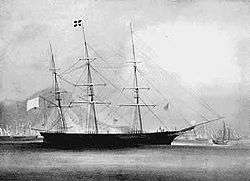Howland & Aspinwall
Howland & Aspinwall was a merchant firm based in New York City in the 1830s and 1840s. It specialized in the Pacific Ocean trade, especially the importing of goods from China. It is best known for taking a pioneering role in the financing of clipper ships, especially the American-built Rainbow and Sea Witch.[1][2]
History

The firm, originally known as G.G. & S.S. Howland, was founded by brothers Gardiner Greene Howland and Samuel Shaw Howland.[3] In 1832, upon the admission of their clerk, William Henry Aspinwall, the firm became known as Howland & Aspinwall.[4]
Howland & Aspinwall imported high-status goods such as porcelain, silk, and tea from China, and sold them to Americans of means. Import duties paid by firms such as Howland & Aspinwall played a significant role in the financing of the American federal budget during the 1840s.[5]
Pacific Mail Steamship Company
In 1848, as a result of the United States's acquisition of California, partners G.S. Howland, S.S. Howland, and William Henry Aspinwall turned their attention from the China trade to California traffic. Improvements in the marine steam engine had begun to make clipper ships and other fast sailing ships obsolete. With other New York businessmen, the Howland and Aspinwall interests formed the Pacific Mail Steamship Company. Pacific Mail eventually became American President Lines, which is now part of Neptune Orient Lines.[6][7][8]
Legacy
Part of the Aspinwall family fortune was eventually bequeathed, through paternal grandmother Mary Aspinwall Roosevelt, to Franklin D. Roosevelt, 32nd President of the United States.
References
- "The Sea Witch". eraoftheclipperships.com. 2009. Retrieved September 25, 2009.
- D. Blethen Adams Levy (2009). "Captain Robert "Bully" Waterman". The Maritime Heritage Project. Retrieved September 25, 2009.
- Kienholz, M. (2008). Opium Traders and Their Worlds-Volume One: A Revisionist Exposé of the World's Greatest Opium Traders. iUniverse. p. 403. ISBN 9780595910786. Retrieved 31 January 2018.
- "Obituary: William H. Aspinwall" (PDF). New York Times. January 19, 1875. Retrieved December 16, 2008.
- "William Henry Aspinwall". www.panamarailroad.org. The Panama Railroad. Retrieved 31 January 2018.
- Somerville, Col. Duncan S., The Aspinwall Empire, p. 22, Mystic Seaport Museum, Inc., Mystic, CT, 1983.
- Niven, John, The American President Lines and its Forebears 1948-1984, p. 15, University of Delaware Press, Newark, NJ, 1987.
- Elias, Rahita, Beyond Boundaries: The First 35 Years of the NOL Story, p. 8, Neptune Orient Lines Ltd., 2004.